I work in a Medical Research Institute, and the nature of research is that people travel a lot for their careers. My current Divisions include scientists and students from France, Germany, Switzerland, Algeria, China, New Zealand, Sweden, The Netherlands, The Cook Islands, Afghanistan, Japan, Brazil, England, the USA, Serbia, Spain, Iran, India, Scotland… oh yes, and a few Australians. (I’m sure I’ve missed a country or five in there, actually). And of course, at least half of the Australians – myself included – in the lab have parents who were born overseas.
So tomorrow we are celebrating Australia Day a day early by having a lunch for our two Divisions, with everyone bringing a dish from home. Wherever home is for the person in question. (I wish I could say this was my idea, because I think it is absolutely wonderful, but one of the RAs came up with it, and more power to her.)
As it happens, I’m one of the few people in the lab who is of Italian extraction, and since food from home often means food of one’s childhood, I’ve decided to have another go at making my Nonna’s pizza recipe. So far tonight, it’s been a case study in why you should add the water gradually, but we’ll let that pass for now.
Nonna, as I believe I’ve mentioned before, had two traditional pizzas she made for us when we visited – one topped simply with oregano (green pizza), and another topped with tomato passata (red pizza), and maybe the odd olive or anchovy or pepper. (It’s the cuisine of poverty – you don’t have many ingredients, but you make the best of the ones you do have.) But she was also very fond of spoiling her sweet-toothed grand-daughter, so when I was quite little, she invented a sultana pizza which she would make at the same time. I’ve never really grown out of it. I’ve also never made it successfully, largely because until recently, the only recipe I had for Nonna’s pizza was extremely vague – Nonna knew all the quantities by feel and cooks pizza ‘until it is done’, which is not very helpful to the novice cook! The recipe I have now (via my aunts) has actual quantities for everything except the water, and, as I will explain later, I’ve learned this evening just why the water measurement is as vague as it is – so I’m hoping I’ll get it to work (I’m writing this while I wait for it to rise the second time). I’m also going to make oregano pizza, of course, but what I’m truly hoping to feed my colleagues tomorrow is my Nonna’s sultana pizza – pizza Serafina!
Your Shopping List
2 small potatoes (about 165g) 1 kg bread flour 1 tbsp salt 35 g fresh yeast (the kind that is a beige, spongey block, not the powdered kind) 100 ml olive oil, plus more for your hands. Oh yes, definitely more for your hands. ‘Enough water to make a sticky dough’. This is somewhere between 450 and 550 ml. Which is to say, it was 550 ml a couple of weeks ago, but tonight that turned out to be way too much and my dough is impossibly sticky and I couldn’t knead it properly at all. 2 tbsp oregano, or 175 g sultanas and 2 tbsps raw sugar, or about 500 ml passata, or pick two of these options and use half of the quantity.Now what will you do with it?
Start by peeling your potatoes, halving or quartering them, and boiling them until cooked. Don’t throw out the water – you’ll want it for the yeast – but fish out the potatoes and push them through a seive to mash them finely.
Let the water cool until it is slightly warm to touch, but not hot. Err on the side of excessive coldness – yeast will rise eventually at cold temperatures, but too much heat will kill it. Pour it into a measuring jug and top it up to about 400 ml, which ought to be safe!
Put your 400ml of lukewarm water into a big bowl, and crumble in the yeast. Actually, it isn’t all that crumbly, but break it up a bit, and then stir it around with a fork to dissolve. Don’t worry about leaving it to get frothy – I’ve tried doing that twice and it doesn’t seem to work that way, but still rises beautifully.
Using a wooden spoon, stir in the flour, salt (yes, you really want this much salt – it prevents the yeast from taking over the universe, and when you see how much this monster rises even without yeast, you will thank me), mashed potato and olive oil. Mix together well. Add in about another 50 ml of water, and more if needed (very slowly! Trust me!), to make a sticky dough. When I say sticky dough, you are going to be putting olive oil on your hands to work this, so you can afford to be sticky, but if it is so wet that even olive oil can’t help you, you’ve gone too far.
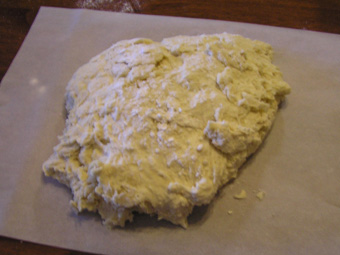
Some kneading required. This dough was an absolute nightmare to work and next time I really am giving up and adding more flour.
The reason I can’t be more specific is that different batches of flour absorb water in different quantities and are different again in different weather. Isn’t that helpful? So you do have to go by feel a bit. I can tell you, though, that every recipe I’ve used from the US has given me a dough that was far too tough and dry, so I’m guessing that if you are buying your flour in the US, you will need less water to get the right consistency than I need in Australia.
Now for the fun part, where you knead it. Pour olive oil into one hand and rub your hands together as though you are washing them. Knead the dough for about 10 minutes (you may need to oil your hands again a few times), until it changes consistency – it will go from being rough to smooth, and then it will become very much one entity – when you fold it over itself, the fold will disappear. I can’t describe it well, but you will know it when you see it. I recommend kneading this in the bowl or on greaseproof paper, or you will never get it off the table.
If you’ve had the same problem I did this evening, definitely keep it in the bowl, and work it as well as you can, prodding it and folding it and turning it but being aware that you are never really going to get that kneading action. It does change a bit when it’s ready this way, too, becoming extremely elastic and again getting that one entity thing happening.
Put the dough into a clean, oiled bowl – a very big one – and let it rise for about an hour, or until it comes to get you. Seriously, this dough rises with terrifying enthusiasm.
It will more than double. I cover my dough with a tea towel, but glad wrap also works – you don’t want it to dry out on top. Dough likes warm, humid weather, so it’s having a party tonight, let me tell you, but if I’m doing this in winter, I time it for a load of laundry and put it on top of the dryer, or else I make stock and put the dough on top of the rangehood.
When the dough is monstrous and possibly sentient, punch it down (unless this goes against your pacifist principles, in which case you may have a problem, because I’m fairly sure the dough does not have any such scruples) and divide into two (unless you have a truly humungous baking tray, you will be making two large trays of pizza). If you are doing oregano or tomato pizza, cover the bowls and let the dough rise for another hour. If you are doing sultana pizza, first knead in the sultanas, and then let it rise. Incidentally, if you have made an excessively wet dough, this will be very hard work, because it really gives new meaning to elastic.
After the second rise, you are ready to shape your dough! This can be tricky, because the dough is elastic and not at all co-operative. I find this much dough fits two biscuit sheet tins quite well. Grease the baking sheets with a little olive oil (I know you are using a lot of olive oil in this recipe, but at least it’s a good fat), and press one lot of dough out onto each. This will take a bit of time – you keep pushing it out towards the corners, and it comes bouncing back towards the centre. Especially with the aforementioned stupidly sticky dough that I made this evening.
Cover everything again and let it rise for another half hour or so. At some point during this time, preheat the oven to 230°C, and if you have the option of fan forced and heat coming from the bottom of the oven, this is ideal.
For oregano pizza, sprinkle the surface of the pizza with the dried oregano (you can drizzle with olive oil first, if you like). If your dough is a sane consistency, you can press indentations into it with your fingers for the oregano to fall into. No such luck for me this time.
For sultana pizza, sprinkle all over with the raw sugar.
For tomato pizza, put little indentations in the pizzas if you can, and then spread the passata all over both pizzas. Sprinkle with a little oregano and salt or chilli, or add a few – a very few! – chopped olives, anchovies, salami slices mushrooms or green capsicum pieces, but really do not go overboard here.
Once everything has puffed up again, bake for around 12-15 minutes, or until puffy and a bit golden and cooked through. Sultana pizza burns quickly, so watch it!
Cut into squares with scissors and serve warm or at room temperature. Mangia!
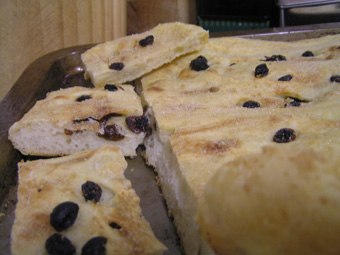
Not my best work, alas, but still good. Maybe next time I'll perfect it... ETA: Actually, the texture the next morning is just about right. Maybe it was supposed to be that sticky after all?
Variations
What? You want variations? This is tradition, I tell you! Though Nonna did sometimes put sliced apple on the sultana pizza.
OK, firstly, you’ve probably noticed that these pizzas are vegan. I really don’t know about bread making with gluten-free flour, so please don’t ask me! I do think this would work with spelt, or with part wholemeal flour, though it would take longer to rise. And substituting in some semolina would also work, though be warned – semolina pizzas and breads dry out much faster than ordinary wheat ones, and also, semolina absorbs water differently.
If you are concerned about fat content, you could use less oil and more water in the dough, but this would give a somewhat drier texture. You could also use a bit less salt (say 2 teaspoons), but do remember that it serves a chemical purpose here, and don’t omit it entirely unless you want bread full of big holes (which, if I recall correctly, is a Tuscan specialty, but not the proper Corletano pizza I am aiming for here).
Honestly, I’m sure you can think up some toppings yourself, but keep them simple for this kind of pizza. A couple of fairly traditional ones are pizza bianca, which just has flakes of salt and nothing else, or pizza with grapes and fresh rosemary through it, which may be where Nonna got the sultana pizza idea.

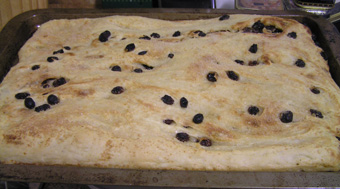

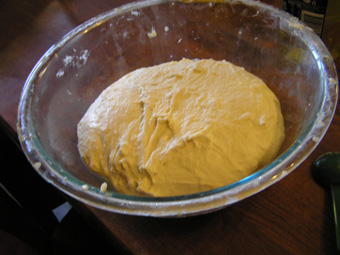


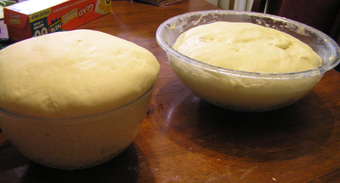

2 comments for “Recipe: Pizza Serafina (Sultana pizza)”